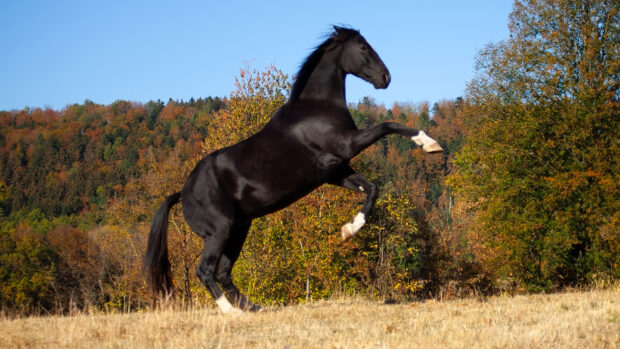Vets have urged owners to be on guard following a spike in laminitis cases around the country. Practices have reported a higher than usual number of cases this year, which “needs to be taken seriously”.
H&H vet Karen Coumbe said Bell Equine in Kent has seen a “huge number” of cases recently, and more this year than last.
“It’s not just the fat ponies, we’re seeing it across the board,” she said. “The grass is a huge contributory factor, but it’s multifactorial; hormones, horses that are overweight and insufficient exercise.
“Laminitis is an awful disease, sadly with poor outcomes in many cases, despite everyone’s best efforts, and prevention has to be better than cure. The key message is watching your horse’s weight and being aware of what you’re feeding. It is always best to look at the bigger picture.”
British Equine Veterinary Association council member Imogen Burrows told H&H that grazing quality and quantity tend to alter rapidly throughout the seasons, and “perhaps we are not adapting our grazing management strategies as promptly and effectively as we could”.
“With the recent variable weather, grazing muzzles and electric fencing may have been kept in summer storage and not quite made it out yet, when in fact these grazing intake reduction tactics should ideally be in place as soon as pastures start to green up,” she said.
“We cannot solely blame the rapid arrival of lush grazing on the perceived increase in laminitis – but it adds another risk factor to the mix, and without mitigation, more risk results in more laminitis.”
Ms Burrows added that as many spring competitions were cancelled owing to the wet weather, “perhaps decreased competition demands have led to reduced exercise, a key factor in the management of equine metabolic syndrome (EMS) and insulin sensitivity”.
“It is well recognised that up to 80% of laminitis cases are caused by endocrine disorders, pituitary pars intermedia dysfunction [Cushing’s disease] and EMS. However, with our dedication to providing the ‘best care’ for our horses year-round, winter has ceased to have the slimming effect it used to,” she said.
“Regardless of our perceptions of the frequency of laminitis occurring currently, we must consider laminitis the year-round threat that it is, identifying underlying causes and target risk factors year-round too. Risk can be reliably assessed to help prevent disease before it starts, using factors including fat scores, endocrine status and basal insulin levels. Laminitis remains responsible for a significant proportion of equine deaths in the UK. This demands we must do anything we can to prevent this devastating disease.”
Vet Edd Knowles of Bell Equine told H&H the number of cases tends to vary from year to year, and this can be dependent on the weather and grass growth. He said that the “vast majority” of the cases the practice and lab are currently seeing are hormone-related.
“Traditionally, the highest incidence of laminitis occurs typically in May or June, so it’s not unusual, but this year has been particularly marked. Some cases can be quite mild and sometimes people can be a bit blasé about it, but there are enough nasty cases out there that it needs to be taken seriously,” he said, adding that exercise plays an important role in managing horses and ponies at risk.
“There are some studies showing that even small amounts of exercise is enough to make a difference. You don’t have to be galloping up hills for hours. Our message is that, assuming the horse doesn’t have active laminitis at the time, any exercise is better than nothing,” he said.
You might also be interested in:

Grazing muzzles – what are your options?

Electric fencing for horses – everything you need for a temporary setup or strip-grazing

Laminitis: how to spot the signs, plus treatments and ways to prevent it

Hopes new drug can help laminitis cases – but good management remains key

Subscribe to Horse & Hound magazine today – and enjoy unlimited website access all year round
Horse & Hound magazine, out every Thursday, is packed with all the latest news and reports, as well as interviews, specials, nostalgia, vet and training advice. Find how you can enjoy the magazine delivered to your door every week, plus options to upgrade your subscription to access our online service that brings you breaking news and reports as well as other benefits.




